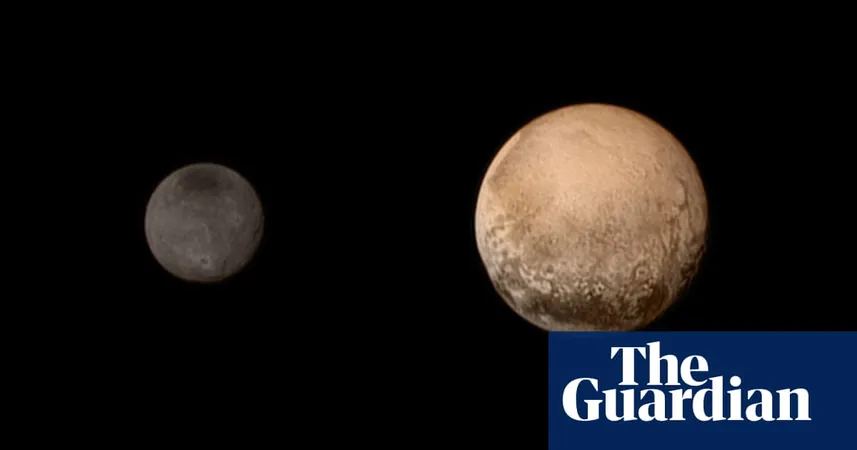
How Pluto's Largest Moon Was Born: The Surprising 'Kiss and Capture' Theory!
2025-01-06
Author: William
The Birth of Charon: A New Perspective
A fascinating new theory has emerged from scientists studying the origins of Pluto’s most significant moon, Charon. Once considered the ninth planet of our solar system, Pluto is now designated as a "dwarf planet" and boasts five known moons. Among them, Charon stands out with a diameter of approximately 754 miles—over half that of Pluto itself.
The Unique Dance of Pluto and Charon
What makes this relationship particularly unique is that Pluto and Charon engage in a mutual orbit around each other, unlike Earth, where our moon revolves solely around our planet. These icy celestial bodies are situated in the Kuiper Belt, a region beyond the orbit of Neptune packed with ancient, icy relics from the solar system’s formation.
The 'Kiss and Capture' Theory
Researchers propose an intriguing scenario called “kiss and capture,” suggesting that Charon initially collided with Pluto in a gentle encounter. This is not just a whimsical take; it has rooted scientific reasoning. After this collision, the two bodies briefly rotated together, much like a massive snowperson, before drifting apart. This interaction allowed them to maintain their distinct forms while exchanging some material during the event.
Dr. Adeene Denton's Insights
Dr. Adeene Denton from the University of Arizona, who led the research, explained that because Pluto spins rapidly before the collision, it effectively “pushes” Charon away, leading to its gradual migration into orbit around Pluto. This innovative model counters older theories that suggested Charon was born from a catastrophic impact that deformed both bodies into a fluid-like state before they were captured into orbit.
Research Findings and Implications
Published in the journal *Nature Geoscience*, the researchers created advanced computer models that considered the mechanical strength of Pluto and Charon. They highlight that previous models—designed for massive galaxies or giant planets—overlooked the importance of materials’ strength in smaller bodies. Unlike large, gaseous entities treated as fluids, these rocky and icy bodies would react differently under collision, responding more like solid materials.
Potential Outcomes of the Impact
Though the team is still investigating whether Pluto's smaller moons were formed from debris resulting from this collision, they believe the impact could have significant implications for the geological development of both Pluto and Charon. The event may have introduced substantial heat into Pluto, possibly giving rise to subsurface oceans and initiating new geological processes. As Denton noted, “The impact dumps a bunch of heat into Pluto, followed by more heating as Charon starts to move away.”
Broader Implications for the Kuiper Belt
Moreover, this “kiss and capture” phenomenon could explain a broader trend in the Kuiper Belt, where eight out of ten of the largest objects have large satellites like Charon. This suggests that such events were common during the formation of our solar system, posing exciting new questions about the evolution of celestial bodies in this distant region.
Conclusion and Future Research
In summary, as research continues, Pluto and Charon's unique relationship could usher in a deeper understanding of our solar system's formation and the dynamics of celestial motions in the mysterious Kuiper Belt. Stay tuned—it seems the cosmos still holds many secrets waiting to be uncovered!



 Brasil (PT)
Brasil (PT)
 Canada (EN)
Canada (EN)
 Chile (ES)
Chile (ES)
 Česko (CS)
Česko (CS)
 대한민국 (KO)
대한민국 (KO)
 España (ES)
España (ES)
 France (FR)
France (FR)
 Hong Kong (EN)
Hong Kong (EN)
 Italia (IT)
Italia (IT)
 日本 (JA)
日本 (JA)
 Magyarország (HU)
Magyarország (HU)
 Norge (NO)
Norge (NO)
 Polska (PL)
Polska (PL)
 Schweiz (DE)
Schweiz (DE)
 Singapore (EN)
Singapore (EN)
 Sverige (SV)
Sverige (SV)
 Suomi (FI)
Suomi (FI)
 Türkiye (TR)
Türkiye (TR)
 الإمارات العربية المتحدة (AR)
الإمارات العربية المتحدة (AR)